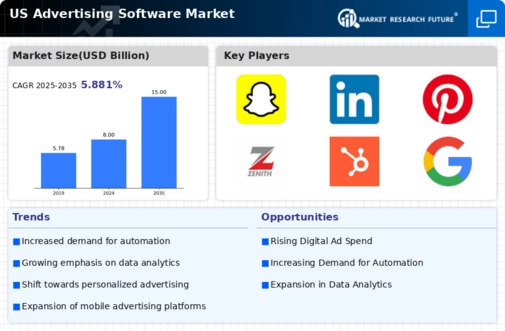The US Advertising Software Market is characterized by robust competition and ongoing innovation as companies strive to enhance their offerings and capture market share. This space attracts a diverse range of players, including established tech giants and innovative startups, all focused on providing businesses with advanced tools to create, manage, and optimize their advertising campaigns. As digital advertising continues to grow, fueled by trends like programmatic advertising and the increasing use of data analytics, the competitive landscape is continuously evolving.
Companies within this market are constantly seeking to differentiate themselves through unique features, pricing models, and strategic partnerships to address the various needs of advertisers, ranging from small businesses to large enterprises.Snap Inc. has carved a significant niche in the US Advertising Software Market by leveraging its innovative platform that primarily focuses on ephemeral content and engaging multimedia formats. The company's strengths lie in its ability to harness the popularity of visual storytelling through tools that allow advertisers to connect effectively with younger demographics.
With a strong presence in mobile advertising, Snap Inc. offers unique ad formats, including augmented reality experiences, which enhance consumer engagement and brand visibility. Their commitment to continuous feature improvement and user experience optimization makes them a prominent player. Additionally, their strategic partnerships with various brands have solidified their market position, allowing businesses to utilize creative advertising solutions that resonate with their target audiences.LinkedIn, another key player in the US Advertising Software Market, has established itself as the go-to platform for B2B advertising.
LinkedIn's strength lies in its ability to connect businesses with professionals through targeted advertising solutions focused on lead generation and brand awareness. The company offers a range of products such as Sponsored Content, Text Ads, and InMail campaigns designed specifically for engaging business professionals and decision-makers. LinkedIn’s vast database of user profiles allows advertisers to create highly targeted campaigns that yield better results. The company’s presence in the market is further bolstered by acquisitions of complementary services and technologies that enhance its advertising capabilities.
As LinkedIn continues to integrate new tools and features to optimize advertising solutions, its focus remains on providing measurable outcomes for its users, reinforcing its strength in the competitive landscape of US advertising software.












